René Magritte in 10 Paintings
René Magritte (1898–1965) stood at the heart of Surrealism, yet his art leaned toward a more figurative vision. He transformed ordinary objects...
Errika Gerakiti 21 November 2025
James Tissot was a 19th-century French painter, mostly known for depicting the life of high society in London and Paris. Painting in mostly an academic style, there are elements of Impressionism in his work. Women play a pivotal role in his painting. He loved painting them and their stylish outfits.
James Tissot left Paris for London in 1871, where he established a successful career as a painter and caricaturist. In 1876, he met Kathleen Newton and began a relationship with her. They never married, probably because Tissot was Catholic and Newton was divorced. However, they remained together until she died in 1882 from tuberculosis. In this painting, Newton is depicted in a languid pose on a sofa, evoking the mood of a relaxing summer afternoon. Through the window behind her, we can see a glimpse of the beach. The painting is part of a series representing the months of the year.
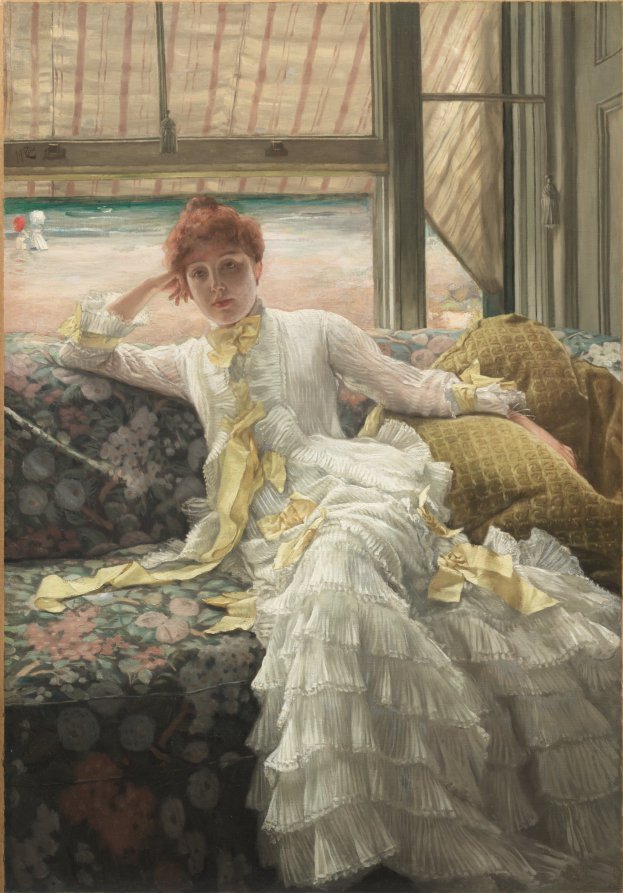
James Tissot, Seaside (July: Specimen of a Portrait), 1878, Cleveland Museum of Art, Cleveland, OH, USA.
On a fine autumn afternoon, a group of young people is having a picnic by the lake. The painting is set in the artist’s garden in the affluent suburb of St John’s Wood in north London. The woman on the right is, once again, Kathleen Newton. She averts her gaze both from the viewer and her friends and takes in the lovely setting. Behind her, the man and the woman are flirting. The old woman in the far left is their chaperone, but she has fallen asleep and doesn’t take notice of the young people.
Édouard Manet’s influence is striking in this piece, especially his Luncheon on the Grass. However, Tissot’s painting is far less shocking and focuses more on the loveliness of everyday life.
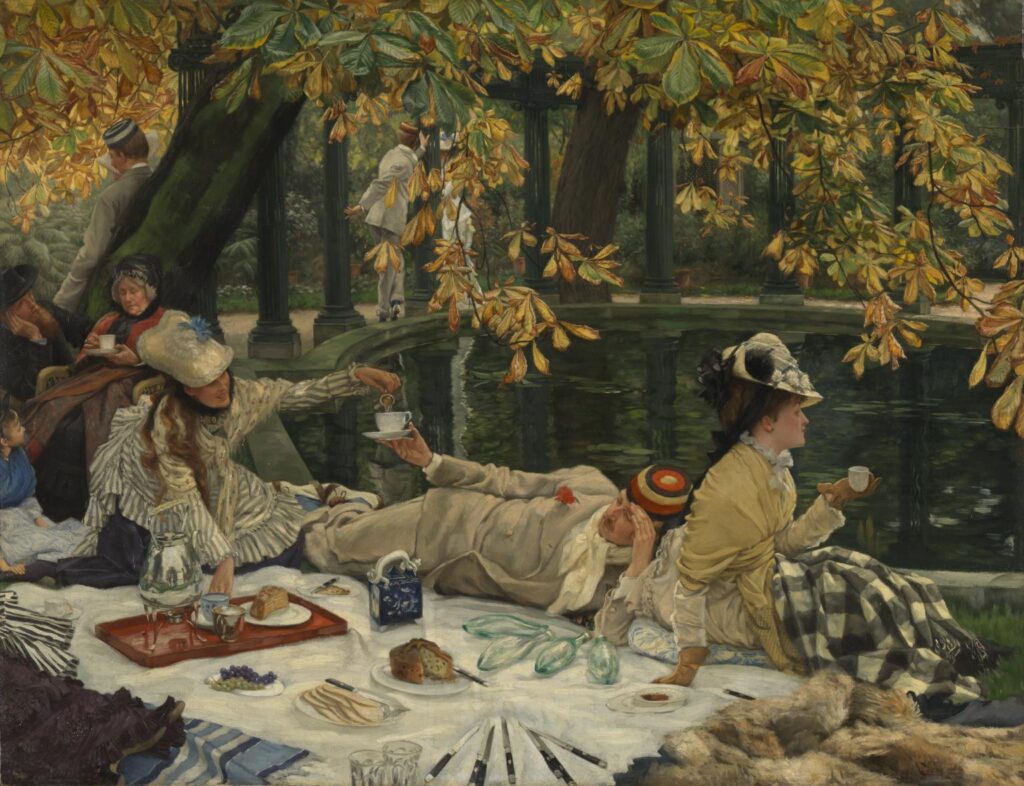
James Tissot, Holyday, c. 1876, Tate, London, UK.
James Tissot was very interested in the subtle nuances of behavior in the Victorian upper class, especially among young people. In this painting, we see another flirting couple. The young man in the naval officer’s uniform is flirting with the young woman with the yellow ribbons in her dress. She is delighted and hides her face with her fan to mask her feelings. Among them is another woman, possibly a chaperone. She has eyes only for the other woman, trying to figure out if something improper is taking place.
The erotic and flirtatious atmosphere of the painting is enhanced by the care Tissot gave to the hourglass figure of the woman with the fan. We can also see the influence of Japanese printmaking in Tissot’s work in the asymmetry of the composition.
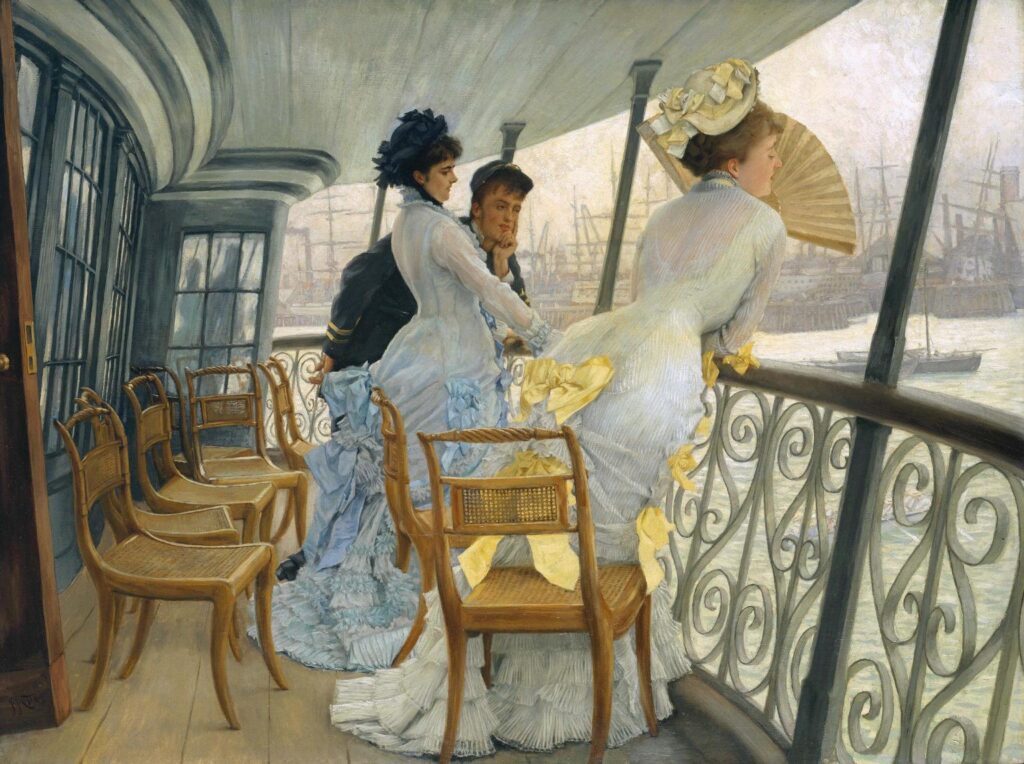
James Tissot, The Gallery of HMS Calcutta (Portsmouth), c. 1876, Tate, London, UK.
This painting shows a social party aboard a ship on the Isle of Wight. It is a summer afternoon, and everyone is having a good time. Tissot, in the way of Manet, wants to show a scene of modern life.
An interesting note is that many women in the painting wear the same dresses. There are two women in the front and a group of women in the upper right. The pairing of dresses was a trend of the time, established by the royal family. Moreover, mass-produced clothing made this easier.
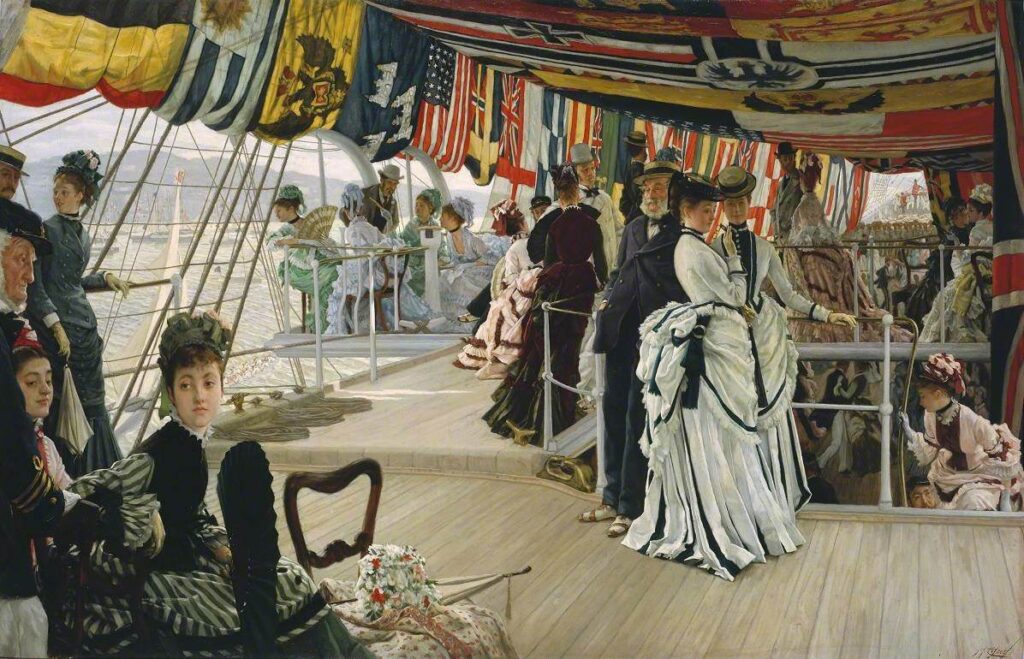
James Tissot, The Ball on Shipboard, c. 1874, Tate, London, UK.
In Portsmouth Dockyard, we see two women and a man inside a boat. The man is a naval officer, indicated by his military uniform. The story of the painting is quite simple. The man must choose between these two women. He turns away from the frowning woman on his left to the smiling one on the right. He has made his choice. Behind them, we see the shops of the Portsmouth naval base.
This is a reworking of another painting called The Thames that Tissot exhibited the previous year at the Grosvenor Gallery. The Thames was poorly received and shocked London society due to the questionable morals of its protagonists.
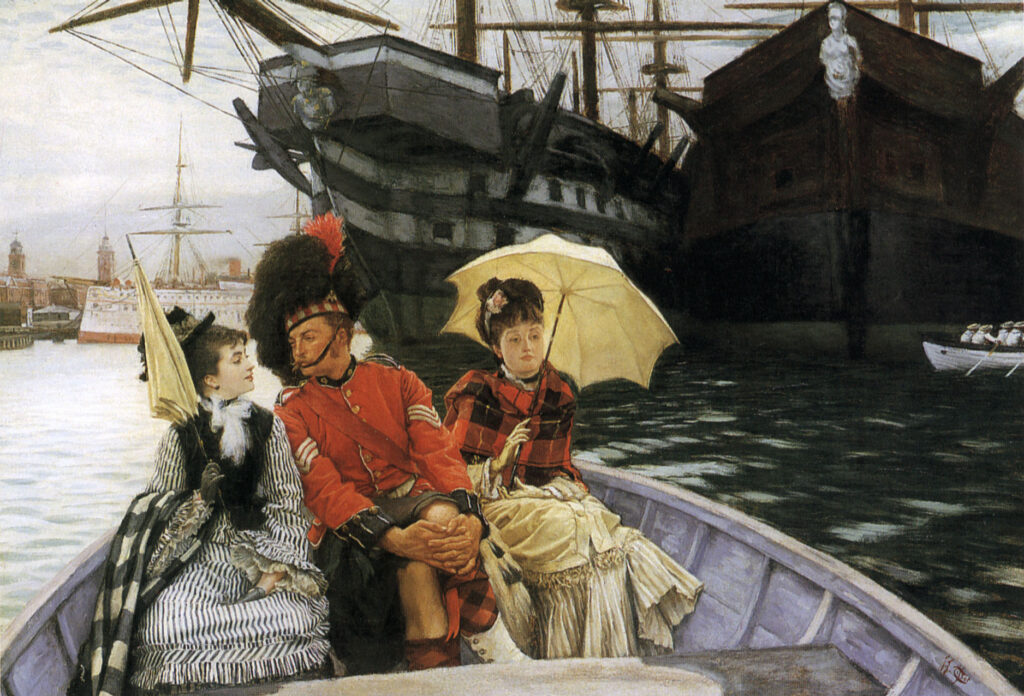
James Tissot, Portsmouth Dockyard, c. 1877, Tate, London, UK.
Towards the end of his career, Tissot abandoned the high society subjects he was known for and turned to biblical themes. Behind this radical change was an event that changed him profoundly. While visiting the Church of St. Sulpice in Paris, Tissot experienced a religious vision, after which he abandoned his former subjects and decided to embark on a project to illustrate the New Testament.
This watercolor is part of this series. According to the testament, Mary and Joseph live in Nazareth but must journey to Bethlehem, the ancestral home of Joseph’s family, to be counted in a census imposed by the Romans. On their arrival in the town, Joseph searches for lodgings without success. They finally find shelter in a barn where Mary gives birth to Jesus. Unlike many artists of the period, Tissot tried to depict the subject as close to reality as possible. He traveled to the Middle East to get a sense of the land and the people and recorded everything he saw.
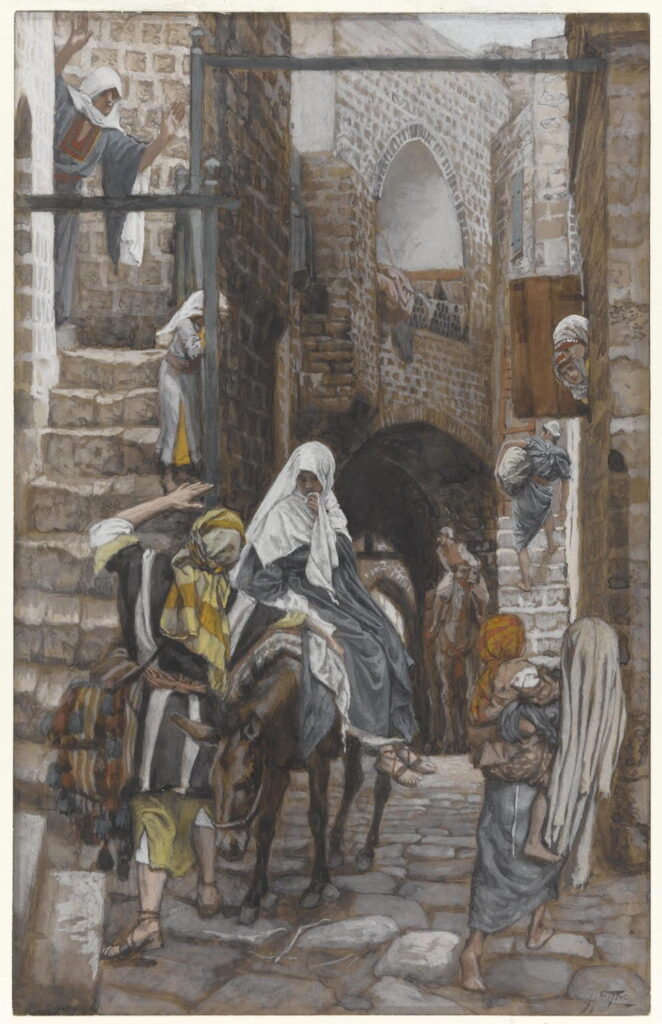
James Tissot, Saint Joseph Seeks a Lodging at Bethlehem, 1886–1894, Brooklyn Museum, New York City, NY, USA.
Tissot, along with many other artists of this period, was interested in subjects related to the Paris nightlife and entertainment. The notion of going out at night was something relatively new, made possible by the advancements in technology, such as electric lights. The circus was popular and, in this painting, we see the Amazons. Beautiful women dressed in shimmering attire raced horses at top speed around the interior track of the Hippodrome de l’Alma.
Tissot places the point of view of the piece inside the racetrack, an unusual choice that imbues the painting with life. We are so close to the performers that we almost touch them. Another interesting choice is the angles. Inspired by Japanese woodcuts, Tissot leaves the head of the rightmost horse out of the picture’s frame and half the head of the horse on the left. The result is a sort of snapshot, adding a modern touch to the piece.

James Tissot, Ladies of the Chariots, 1883–1885, Rhode Island School of Design Museum, Providence, RI, USA.
The Circus Lover is part of a series of 15 paintings entitled Women of Paris, which show women of various social classes. Each painting looks like a snapshot, as if the women are caught unaware. The Circus Lover shows a “highlife circus,” in which the amateur performers were members of the aristocracy.

James Tissot, The Circus Lover, 1885, Museum of Fine Arts, Boston, MA, USA.
In London Visitors, we see a couple sightseeing in London. They are standing on the steps of the National Gallery. The woman is pointing her umbrella towards Trafalgar Square while the man consults his guidebook. In front of them stands their guide, looking rather bored. In the background, there is another guide boy in the same uniform explaining something to a young woman.
What really sparked Tissot’s interest here is the woman in front. Her dress is far more luxurious for a day sightseeing, and her demeanor breaches the rules of Victorian propriety, as she unabashedly looks at the viewer or someone else outside of the painting. On a more technical note, this work is a beautiful study of black, white, and gray.
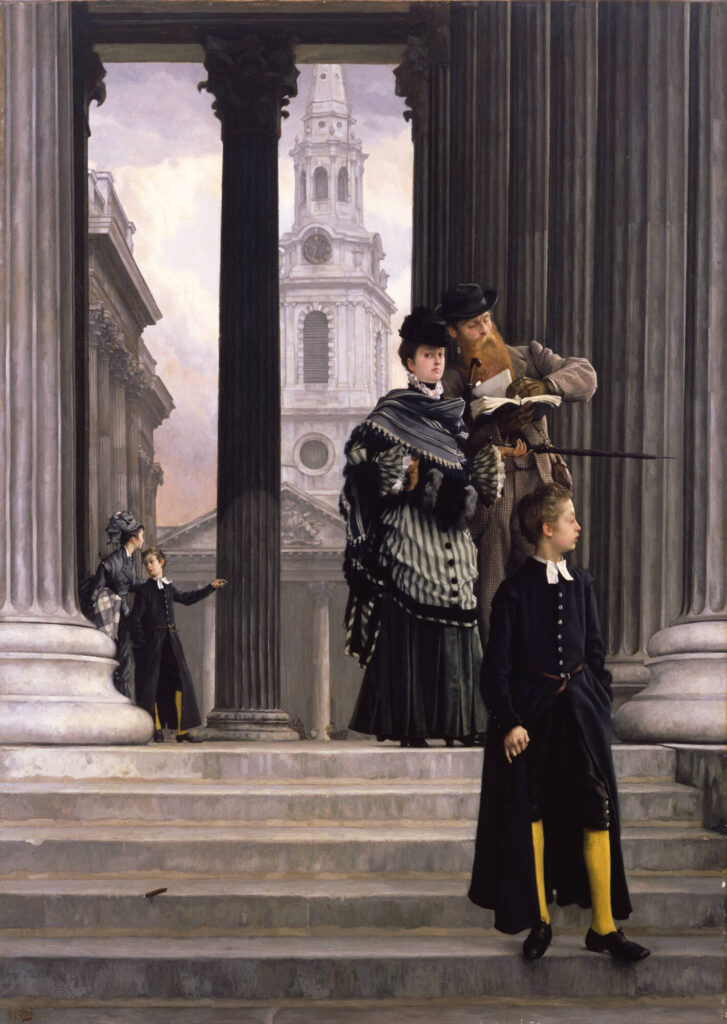
James Tissot, London Visitors, c. 1874, Toledo Museum of Art, Toledo, OH, USA.
The new medium of photography was very influential to artists of this period, among them Tissot. The idea that you can capture a scene from contemporary everyday life, with just a click, appealed to them and is a central idea in Impressionism and Realism. In this painting, two women are helping a man raise a line of flags. The title may refer to the Union Jack flag at the top.

James Tissot, The Holiday (Still on Top), 1874–1875, Auckland Art Gallery, Auckland, New Zealand.
DailyArt Magazine needs your support. Every contribution, however big or small, is very valuable for our future. Thanks to it, we will be able to sustain and grow the Magazine. Thank you for your help!